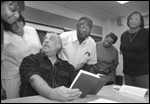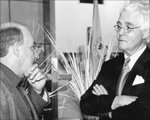This article, Pull Up Your Chair, is an excerpt from Max De Pree, Called to Serve: Creating and Nurturing the Effective Volunteer Board (Copyright 2001 Wm B. Eerdmans Publishing Co.), used by permission, all rights reserved.
Dear Verley: Perhaps the most crucial element in turning a group of volunteers into an effective organization is the perception the chairperson has of her role and the way that she carries out her responsibilities. One way to think about this is to see the chairperson’s role as a needs-meeting job. Just as the organization and its clients have needs to be met, so does the board itself. Keep in mind that most of these are matters that the chairperson is uniquely positioned to deal with. A chairperson cannot dodge her responsibilities. She must come to the job with the time and flexibility to shoulder
her duties.
Believe it or not, I have to remind you that the chairperson chairs a board meeting, not a president or senior staff person. They are important resource persons, but the chairperson chairs. She gives leadership to the devotional bond-making in the group. She manages the board’s time. She maintains appropriate focus. Not everything, as you know, carries equal weight. She senses mood and response. She calls the rest and toilet breaks every group needs. She monitors the discussions and at the appropriate time calls for the vote, then follows action with assignment and sets a timetable for reporting back to the board.
| This article is an excerpt from Max De Pree, Called to Serve: Creating and Nurturing the Effective Volunteer Board (Copyright 2001 Wm B. Eerdmans Publishing Co.), used by permission, all rights reserved. To order the Book, call the publisher at 800/253-7521 or go to www.eerdmans.com |
She works continuously at developing her skills in leading meetings, trying always to give each member the opportunity to participate and guarding against the temptation to speak too frequently herself. Bob Greenleaf taught me the advantages of a chairperson’s occasionally declaring periods of silence in meetings for reflection, for absorbing conflicting opinions, for respecting an entirely new idea. I highly recommend it.
In many, perhaps most, organizations there is a president or other full-time staff. The chairperson makes it her business to establish a strong covenant with that person. She commits to his success. She makes time to be available. They work together in designing the agenda and reviewing the board’s effectiveness. They work out together who speaks for the institution. There are usually a variety of publics to be considered, and it should always be clear to the members who speaks for them.
When I was board chairperson at Fuller Theological Seminary in Pasadena, California, Dr. David Hubbard, the president, and I would, of course, find time to talk together when the board met. In addition, we often met for a day at the Denver airport, halfway for both of us. We could work together four or five hours and still be home that evening. These were very fruitful times.
The chairperson is probably the key person when it comes to building trust in the group. Oddly, one of the best ways to build trust is to be sure to share bad news. Of course, other things build trust, such as giving plenty of opportunity to ask questions and to scrutinize proposals. Good communicators build trust. Keeping promises builds trust. Respecting everyone equally builds trust.
The chairperson enables and draws out the members. She gains the contribution of all, never allowing anyone to be isolated. She is an aggressive listener, asking questions that lead to productive answers. She is skilled at guiding the movement away from personal agendas and focusing always on the corporate agenda. She makes it her business to know what’s fragile in the group and deals sensitively with these matters.
Another role of the chairperson is the orientation and education of new members. They need to know the institutional issues, its history and traditions, its past citizens and giants. New members must identify with the institution’s mission, values, and strategies. I believe the best way to work at this is to assign each new member an experienced member as a mentor, especially in the case of people with little or no previous experience on boards because of age, gender, or ethnic background. They can then sit together at board meetings, and they should talk on the phone and even visit together in between meetings.
It’s also important to think about continuing education for the board as a body. One of the important things that Hubbard did was to arrange institutional forums at Fuller. He would bring the faculty and the board of trustees together for these forums, where we all had the opportunity to interact with the speaker and sit together in small groups to discuss the presentations. These were wonderful learning opportunities.
Verley, I’d like to close this letter with two admonitions. The chairperson must be diligent in saying thank you and must be just as diligent in holding the group accountable. By the nature of the chairperson’s position, no one else in the group can hold the board accountable if she fails to do it. Max
A Chairperson’s Guide
Dear Verley: Let’s look at some guidelines for a chairperson, thinking first of the needs of board members. One important need and a source of renewal on any board is the rotation of chairpersons. Always set a time of service for the chairperson. To fail to rotate the chairperson on a regular schedule is a matter of great risk to any board.
Observing these guidelines will make service more effective, more fun, more efficient, and certainly more rewarding. It will increase our respect for our organization and for our own worth and contribution. These guidelines are not magic—just common sense—but they must be put into practice. Since the chairperson’s job is at heart a matter of stewardship, she continually asks herself two questions: What do I owe this group, and what matters?
Build Community: Building community starts with devotional bonding. People who work for love are devoted—devoted to beliefs, principles, values, clients, goals, etc. Discussing our devotedness openly and together builds community. We strengthen that community by recognizing and meeting the needs of the followers. We also build community when together we are successful; so the chairperson focuses on enabling (that is, drawing out) the contribution of each member. He serves the group’s needs rather than his own. The practice of hospitality also builds community, but I’ll get to that later.
Design the Agenda: A purposeful, thoughtful agenda contributes significantly to a group’s effectiveness. We can’t get by with just making a list. In designing an agenda, we include a review of all plans and assignments. We try to lead the group in focusing on goals, opportunities, and problems. Surprises are always difficult to deal with, so we try hard not to let them happen.
The chairperson is a big help to the group when she makes sure ego needs are kept separate from the issues. It helps here to be good at clarifying reality.
One of the great time wasters for any group is the routine giving of progress reports when there’s been no progress. The chair should check with subcommittee chairpersons to ensure there will be substance to their reports. If not, don’t risk frustrating the commitment of good people.
Use the Bell Curve: One way to present a well-designed agenda is to follow the bell curve. This best reflects how boards actually behave. For instance, some folks, like it or not, come late and some leave early. Socially we’re inclined to require a settling-in time, during which we get used to being together again and need a period of easy work. This is the left side of the bell.
Then we’re ready to get down to business, approaching our most productive time as a group. This is when we tackle the heavy stuff. Everybody is there, we have good focus. As we move over the top of the bell, we deal with our most significant matters. One of the sins that many leaders commit is to hold important or troublesome matters until the end of the meeting; these matters ought to be considered at the top of the bell curve when the group’s energy is at its best.
Now we move down the right side of the bell. We do some fun stuff. We tell our stories. Those who leave early get their chance. We wind down to the final, very important item.
Verley, let me tell you a story. Several weeks ago, I received in the mail a letter addressed “Max De Pree, Author of Dear Zoe, Holland, Michigan” and on the bottom of the envelope was a note in red that said, “Please, God, help get this letter to him.” Well, I was astonished that the post office had gone to the trouble of finding me, so I called to thank the postmaster. I told the postmaster the story and thanked him for the special service, and at that point, he really surprised me. He said, “We find about 100 letters like this a week that we have to do some special work on to get them delivered. You’re the first person who ever called to say thank you.”
While you will think of other ways of nurturing the board, never neglect to recognize, celebrate, and say thanks.
Be a Good Communicator: Being in touch with the members in a variety of ways contributes mightily to the effectiveness of the board. It would be difficult to communicate too much.
Start by sending the agenda well ahead of the meetings. This eliminates excuses for arriving unprepared. A friend told me recently that when he gets his agenda package only a day or two before the meeting, he knows he is not being taken seriously.
It’s important to gain the contribution of all members. Some folks seldom speak during the meeting. This does not mean they have nothing to say. It means rather that the chairperson should invite their thoughts in other ways.
I’d like to caution against withholding difficult-to-deal-with information or bad news. It’s often more important to share bad news than good news. Especially in a setting where there is full-time management, the board should never be kept in the dark. It is up to the management to enable the board with all appropriate information. Another way to communicate is by producing usable minutes in a short time. Here are some suggestions:
- Minutes always need a heading that includes the organization’s name, date, time, and place of the meeting.
- State who of the group are in attendance, who are missing, and who presides.
- Make sure the following are recorded concisely: reports, actions, proposals, discussions, referrals, assignments.
- Record that the meeting was adjourned.
- The secretary signs the minutes.
- Distribute to all members as soon as possible.
Practice Hospitality: Hospitality has to do with equity for each member. Enabling each to feel authentic and needed and worthwhile is an act of hospitality. Hospitality includes providing for the needs of the group in the physical setting. For instance, the arrangement of chairs and tables, the quality of the light, the tastefulness of the room demand your attention. Sitting in a circle with no table is a distracting and ineffective way to work, as is sitting at a long, narrow table where members can have contact with only those adjacent to them. Think about the tools we need—our pads and pens; our copies of agenda, minutes, records, and reports; and where we’re to put them. Think, too, about the social needs. Things go better with snacks, drinks, timely breaks, and no anxiety as to where the toilets are.
Hold the Group Accountable: A key responsibility of any leader is to hold the group accountable. We decide what we’re going to do; that is, what outcomes are needed. This is one of the things we measure. We maintain our focus (not everything carries equal weight). We manage our time. We scrutinize our progress, our work patterns, and our results. We never ignore the need to be effective and accountable. We never let talk become a substitute for action. We live by our own rules. If we’re not observing our own rules, we change them. This is a matter of equity and integrity and sets an example for other volunteers. Max
Living with Tensions
Dear Verley: One of the myths of volunteer board work is that you see only fine, well-motivated people who agree on what needs to be done, when to do it, and how to do it. Nothing could be further from reality. Any diligent board suffers certain tensions. Perhaps this letter should be labeled “dire warnings.” Good people disagree, do a little politicking, try to make decisions in the bathroom (the worst form of exclusion), and come to meetings totally unprepared.
I’m not about to promise you that these folks can be changed. Conflict resolution begins with an awareness of the central problems and an openness to dialogue before the lid pops.
We should probably start with a very legitimate tension: tradition versus change. Some folks honestly believe change is our only hope. Others feel that we build our future by honoring our past. You’ll find this is a tough one to balance.
Another thing to keep your eye on, Verley, is the difficulty some folks have perceiving and accepting new realities. Getting your group to have a broad perspective at the same time they keep their priorities in focus is no mean feat.
Tensions predictably arise when an organization or its board confronts a crisis. Crises call for new attention to the purpose of the group and the quality of human relationships, both of which are key to success and faithfulness. When a board finds itself in crisis, it becomes a sin to sit on your hands and hope it will go away. Get to work!
One of the more tendentious matters to arise—seemingly, often, out of thin air—is the need for a leader to move on to another position. Occasionally there is malfeasance. More often, the pace slows, the vision blurs, people make mistakes, weariness sets in, and life becomes difficult. Ineffectiveness moves in like a virus. It’s time for a change. Not only does the board’s decision about what to do have to be scrupulously right, but the way in which the board implements the change has to be as clear and as obvious to everybody as the reasons to change. Once again, hope by itself will not be sufficient.
Evaluating a board member’s performance is guaranteed to produce tension. Suggesting that a volunteer be evaluated seems a little crass, and it probably is—unless we’re serious about our mission, unless we truly believe members want to grow and reach their potential and serve society, unless we take our clients seriously, unless we respect our donors. Good practice indicates we should discuss this with prospective members, so that they are not surprised.
Another tension arises when board members try to move onto management’s turf. Sometimes good members do this without intending to. It’s up to the chairperson to keep an eye on this. The board has assigned the supervision of staff to the president; and the staff deserves only one boss.
Tension may also arise when new members, unaware of decisions made by their predecessors, change board policy and direction when this may not be the best thing to do. This is an area where good staff work can keep the board out of trouble and prevent problems.
The last item I’d like to mention is the tension that arises when the board tries to deal with its own contribution and value to the organization. Deciding what we will measure, deciding who matters and what matters, determining the quality of our service and product—these are not easy things to confront, even though in theory we all agree on their importance.
For a starter, Verley, these are some dire warnings. I guess the fact that board work is so important may be what makes it such a cherished and satisfying challenge. Max
Listening with Faith
 |
|
Dr. James Pollard, seated, speaks to his New Testament class, at the Center for Urban Theological Studies, in Philadelphia. From left standing are Bethany Sudler, Sharon Denson, Leroy McCrea, Joyce Nelson, and Carol Van Pelt. Photograph by |
“We meet them where they are and take them where they want to go,” is how Dr. Verley Sangster describes the purpose of the Center for Urban Theological Studies in Philadelphia. For many lay clergy of modest means and limited formal education, CUTS has been the way up and out into a wider world.
When he became president in 1994, Sangster saw the development of a more effective board as one step toward enhancing the school’s ability to help students. It was only natural to turn to Max De Pree, the man who had been his mentor since shortly after Sangster’s graduation from Fuller Theological Seminary. He asked De Pree to pay a visit and look things over.
Three De Preeisms proved most useful to him:
- Never pull the trigger unless you know where you’re going to bury the body.
- Things really take time.
- If CUTS is going to have a future, it needs a strong, functioning, dynamic board.
In the seven years since Sangster received this wisdom, nurturing the board has been a continuing priority for him. The advice of Called to Serve has been invaluable as he presided over the transformation of an eleven-member, educator- and pastor-dominated board of directors with no real authority into a ten-member board of trustees with governing power. The board’s profile has changed, too, thanks to the institution of term limits. Now four clergy maintain theological integrity for a board otherwise composed mainly of business leaders from Philadelphia and elsewhere. 
As the board began to govern more, accountability and better financial information helped Sangster make the tough decisions that pulled the school out of serious debt. Staff was cut from nineteen to thirteen. Rather than suffering, the CUTS program became more focused. Tuition, which supports operations, has been increased only when tuition at affiliated Geneva College has increased. (CUTS’s tuition is 75 percent of Geneva’s.) Following five years of surpluses, CUTS stood debt-free at May 31, 2001.
Board members have taken their responsibilities to heart, and this year, for the first time, every one contributed financially to the school. President Sangster, emphasizing accountability, has been evaluated annually for three years now, and the board is building a plan for succession.
And where are the center’s graduates? Of more than 800 students, 145 are now pastoring churches. An early student leads the largest church in Philadelphia, and another one in Bangkok reminds those at home that urban centers are everywhere.
Proverbs says that the wise man is one who heeds good advice. Sangster’s advice to those who also seek to improve board performance is simple: “Buy the book.”
—Carole Anne Nelson
Speaking from Experience
 Early in their marriage, Max and Esther De Pree set their sights on living a three-track life: family, work, and service. Many lives have been touched by that third track—a practical ministry of Christian stewardship that freely shares time and talents where needed. In Max De Pree’s case, theological education and its leaders have benefited the most from his thirty-seven years on the board of Fuller Theological Seminary, and his past twenty years serving as a mentor.
Early in their marriage, Max and Esther De Pree set their sights on living a three-track life: family, work, and service. Many lives have been touched by that third track—a practical ministry of Christian stewardship that freely shares time and talents where needed. In Max De Pree’s case, theological education and its leaders have benefited the most from his thirty-seven years on the board of Fuller Theological Seminary, and his past twenty years serving as a mentor.
Mentoring was always part of De Pree’s plan. He had already been mentoring for several years before he retired fourteen years ago as CEO of Herman Miller, Inc., the world’s second-largest office furniture company. “I knew when I left the corporate world, I wanted to be active in teaching leadership principles in Christian circles,” he said in a recent interview. Through individual relationships and in seminars around the country, De Pree has shared his insights about participative, servant leadership.
Like the best teachers, De Pree practices what he preaches—and what he preaches is the importance of relationships in exercising leadership. He mentors about ten people, working with each individually, usually in person or by phone, almost never in writing. The mentee sets the agenda, perhaps one of personal growth, perhaps one of coping with specific business or nonprofit leadership challenges.
“I work primarily by asking questions,” said De Pree. “I ask what it will take for them to reach their potential. If they’re in a leadership role, I ask what kind of community they want to be. It’s not my job to provide answers. If I’ve made a suggestion, I don’t follow up to see if they’ve acted on it. They’re all grownups who are responsible for their own actions.” He confesses, however, he doesn’t want to hear the same complaint time after time from someone who is unwilling to take action.
De Pree emphasizes that nobody gets anything done alone; the most effective leadership takes action in concert with others. He further stresses the humanity of leadership.
Given the directly personal nature of his relationship with mentees, the letters on which Called to Serve is based represent a departure from the ordinary. His intent was to do a little mentoring at large, taking the opportunity to offer some concise, common-sense advice and reminders to people he characterizes as both smart and dedicated: those who serve on nonprofit boards, many of them in the field of theological education. The book is only 102 easy-reading pages long, but its size is in no way proportional to the breadth of expertise and depth of experience that Max De Pree shares with his readers.
—Carole Anne Nelson
Read more articles on the role of the board chair:



























